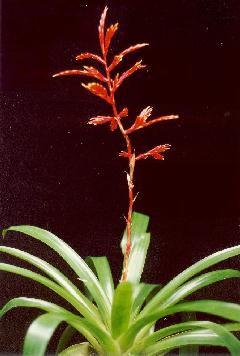
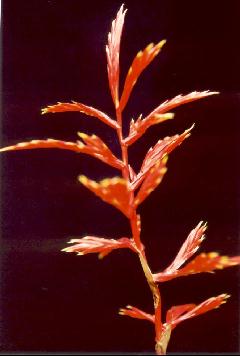
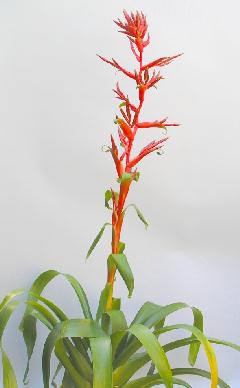
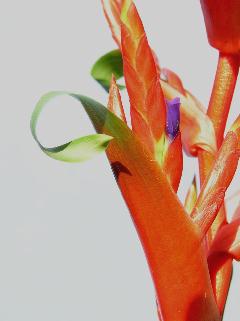
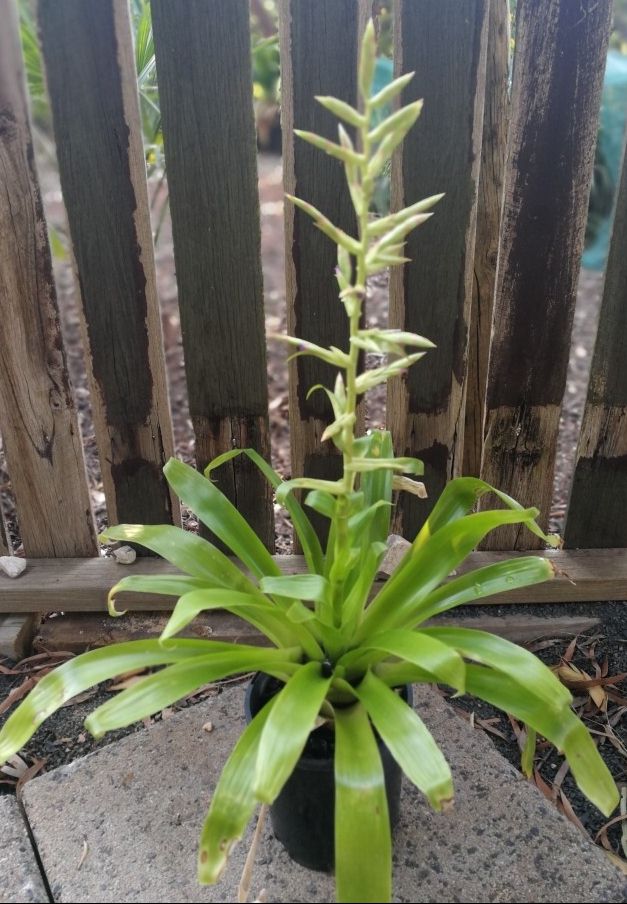
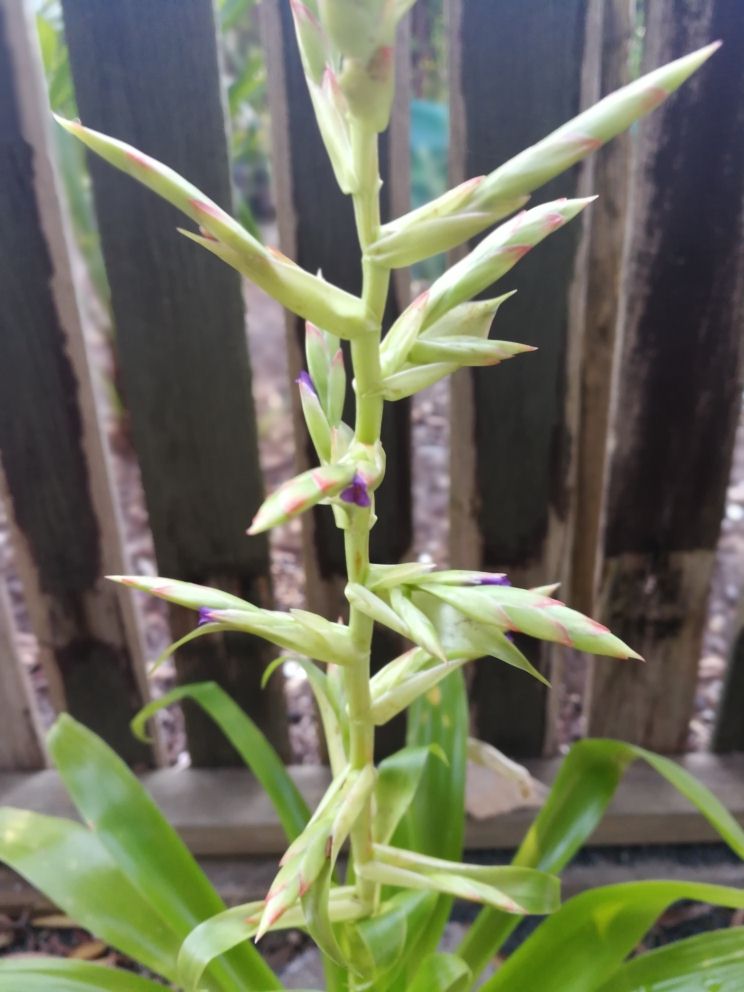
Desc from S&D p721 - 3
Plant stemless, flowering 2.5-15 dm high.
Leaves many in a dense crateriform rosette, 3-4 dm long;
Sheaths conspicuous, elliptic or ovate, 8 cm broad, densely brown punctulate-lepidote; Blades ligulate, acuminate, flat, 3-4 cm wide, thin when dry, subglabrous, glaucous-green.
Scape erect, stout, equaling or exceeding the leaves, glabrous;
Scape-bracts densely imbricate, foliaceous with divergent to spreading blades.
Inflorescence ample, pinnately compound with most of the branches divided to reduced and bipinnate, narrowly sub pyramidal or cylindric, to 8 dm long; axes glabrous, often flexuous toward apex;
Primary bracts lanceolate to broadly ovate with attenuate green blades, red, the lower ones about equaling the axillary branches, the upper ones much shorter;
Branches about 2 cm apart, divergent to spreading, to 15 cm long;
Spikes narrowly lanceolate, acute, subdense, 6-26-flowered, complanate, to 85 mm long, 10 mm wide.
Floral bracts erect, imbricate, elliptic-ovate, obtuse and apiculate, 10-14 mm long, slightly exceeding the sepals, two and a half times as long as the internodes, slightly if at all carinate, subcoriaceous, prominently nerved, glabrous;
Flowers erect, short-stipitate.
Sepals ovate-Ianceolate, obtusish, 9-10 mm long, thin, nerved, glabrous, the posterior ones carinate, short-connate;
Petals linear, obtuse, 15-18 mm long, exceeding the stamens and pistil, blue.
Capsule cylindric, acute, 20-25 mm long.
Type. Warsczewicz in Berlin Hortus s n (holotype B, B photo 1249/30), without exact locality, Guatemala.
DISTRIBUTION. Epiphytic in forest, 1100-2800 m alt, southern Mexico, Central America.
MEXICO. OAXACA: Concordia, Pochutla, I Mar 1937, Makrinius 722 (US); Cerro Azul, 15 Mar 1948, MacDougall s n (US). CHIAPAS: Mount Ovando, Dec 1937, Matuda 2071 (GH); Letrero, Siltepec, 7 Ju1 1941, Matuda 4468 (GH, LL, US); Fraylesca, Siltepec, 13 Mar 1945, Matuda 5281 (CH, US); Motozintla, 15 May 1945, Matuda 5502 (GH, US); San Cristobal, 31 Mar 1949, Carlson 1623 (US); 5 Apr 1957, Foster & Van Hyning 2954 (US); 17 Mar 1960, Van Hyning 6069 (US); 24 Aug 1964, Breedlove 7119 (DS, US); 22 Jan 1965, Breedlove & Raven 8292 (US); Pueblo Nuevo Solistahuacoin, June 1963, Tillett 636-19 (US); 25 Jan 1965, Raven & Breedlove 20003 (DS, US); Tenejapa, 23 Nov 1964, Breedlove 7518 (DS); 2 Oct 1965, Breedlove 12712 (DS, US); 10 Oct 1965, Breedlove & Raven 12958 (DS, US); 23 Sep 1966, Ton 1199 (US); Jitotol, 12 Feb 1965, Breedlove 8891 (DS); Zinacantoin, 18 Feb 1966, Laughlin 141 (US). GUATEMALA. QUICHE: Nebaj, Sacapulas, 13 Jun 1964, Contreras 4985 (LL); Chiul to Boqueron, 1964, Proctor 25313 (IJ, LL, US). HUEHUETENANGO: Huehuetenango to Aguacatoin, 2 Jan 1941, Standley 82009 (F, GH); 82027 (F, GH); San Juan Ixcoy, 4 Aug 1942, Steyermark 50002 (F); San Ildefonso Ixtahuacan, 15 Aug 1942, Steyermark 50550 (F, GH); boundary with Totonicapan and Quezaltenango, Dec 1962, Williams et al 22729 (F). SAN MARCOS: San Rafael Pie de la Cuesta, Mar 1939, Standley 68605 (F); Dec 1963, Williams, Molina & Williams 26000 (EAP, F, US); San Marcos to Castalia, 16 Dec 1963, Williams, Molina & Williams 26199 (EAP, F, US). QUEZALOE TENANGO: Palestina, 21 Jan 1941, Standley 84248 (F); Santa Maria de Jesus, 12 Feb 1941, Standley 87167 (F, GH). ZACAPA: Lorna El Picacho to Cerro de Monos, 16 Jan 1942, Steyermark 42787 (F, GH); 42833 (F, GH); Sierra de las Minas, 13 Oct 1939, Steyermark 29822 (F); 29889 (F). JALAPA: Volcoin Jumay, Jalapa, 1 Dec 1939, Steyermark 32319 (F); 32325 (F); Cerro Alcoba, Jalapa, 2 Dec 1939, Steyermark 32570 (F). GUATEMALA: Volcan de Pacaya, 30 Nov 1938, Standley 58502 (F); 20 Dec 1940, Standley 80773 (F). SACATEPEQUEZ: J. D. Smith 2796 (GH, US); Antigua, 1938-39, Standley 63044 (F). CHIMALTENANGO: Chichavac, 13 Jul 1933, Skutch 406 (US); Los Positos, Las Calderas, 16 Dec 1940, Standley 80296 (F); 80300 (F). SOLOLA: Los Encuentros, 7 Dec 1963, Williams, Molina & Williams 25453 (EAP, F, US). SUCHITEPEQUEZ: Volcan Santa Clara, 23 May 1942, Steyermark 46766 (F). SANTA ROSA: Casillas, Mar 1893, Heyde & Lux in J. D. Smith 4634 (GH, US). HONDURAS. COMAYAGUA: above El Achote, Siguatepeque, 1936, Yuncker, Dawson & Youse 6431 (DPU); 6435 (GH). MORAZAN: Mount Uyuca, 1948, Glassman 1530 (EAP, NY); Standley 13427 (F); 22 Aug 1949, Standley 23086 (F); Aug 1960, Pfeifer 1389 (US); 1396 (US); 11 Ju1 1964, Gilmartin 962-A (US); 962-B (US); 19 Ju11964, 996 (US); San Juancito, Aug 1960, Pfeifer 1955 (US); 2028 (US); 13 Jul 1964, Gilmartin 965-A (US). SALVADOR. AHUACHAPAN: Laguna Verde, 30 Dec 1950, Rohweder 324 (HBG); 325 (HBG); Laguna de las Ninfas, 28 Jan 1951, Rohweder 330 (HBG); 331 (HBG). SANTA ANA: Hacienda Los Planes, 30 Oct 1950, Rohweder 311 to 321 (HBG; 322 (Z),323 (HBG); 26 Aug 1951,337 to 339 (HBG); Hacienda Montecristo, 17 Dec 1950, Rohweder 405 to 408 (HBG); 26 Feb 1951, 409 to 414 (HBG); 7 Jun 1951, 415 to 418 (HBG); 419 (Z); 420 (HBG); 421 (HBG). SONSONATE: Laguna de las Ranas, 14 Feb 1951, Rohweder332 (HBG); 27 Jun 1951, 340 to 343 (HBG); 29 Ju1 1958, Weberling 1285 (Z). LIBERTAD: Finca Los Angeles, 12 Jan 1951, Rohweder 326 to 329 (HBG). SAN VICENTE: Volcan de San Vicente, Mar 1922, Standley 21556 (US); 21557 (US); 7 Mar 1951, Rohweder 333 to336 (HBG); 26 Jul 1951, 344 to 347 (HBG). NICARAGUA. MATAGALPA-JINOTEGA: Matagalpa to Jinotega, 1 Apr 1961, Bunting& Licht 957 (US); 958 (US). PANAMA. VERAGUAS: Santa Fe, Cerro Tute, 25 Mar 1947, Allen 4361 (MO).
Tillandsia guatemalensis L. B. Smith, Contr. U. S. Natl. Herb. 29: 281. 1949; nom. nov.
Allardtia cyanea A. Dietr. in Otto & Dietr. Allgem. Gartenzeit: 20:241. 1852.
Tillandsia cyanea (A. Dietr.) E. Morr. Belg. Hort. 29; 297. 1870, not Linden ex Koch, Wochenschr. 10: 140. 1867.
Tillandsia excelsa sensu L. B. Smith & Lundell, Brom. Yucatan Penin. in Carnegie Inst. Washington Publ. 522: 112. 1940, not Griseb. 1864.
The discovery of a scanty but technically adequate use of the name Tillandsia cyanea, prior to E. Morren's combination forces us to discard his name as a later homonym.
In previous papers I made the main distinction between T. cyanea E. Morr. and T. excelsa Griseb. on the absolute size of the sepals and thereby misdetermined the larger-flowered material of T. cyanea.
The best distinction is in the large secondary bracts of T. excelsa, which are half as long as the broad few-flowered spikes, and in the consistently ecarinate sepals.
Detail from Baker 1889
224. T. CYANEA E. Morren in Belg. Hort. 1879, 297.
T. columnaris E. Morren (NLD.).
Allardtia cyanea Dietrich.
Platystachys cyanea K. Koch.
Leaves 20-30, densely rosulate, lanceolate from a large ovate-oblong base, 2½-3 in. broad, 1½ ft. long, 1½ in. broad at the middle, thin, flexible, glaucous-green, subglabrous.
Peduncle as long as the leaves;
upper bract-leaves with large erect lanceo-late tips.
Panicle lax, 2-3 ft. long, 5-6 in. broad; branch-bracts lanceolate, 2-3 in. long;
numerous branches patent, compound; spikes 1½-2 in. long, ½ in. broad; flower-bracts oblong, ½ - ? in. long.
Calyx as long as the bract.
Petal-blade small, oblong, bright violet. Stamens not longer than the petals. Capsule ¾ in. long.
Hab. Guatemala. Introduced by Warszcewicz about 1856, and again by Rodrigues in 1884.
Tillandsia uyucensis A. J. Gilmartin sp. nov. Ceiba II: 23. 1965.
Planta epiphytica, caulis, ad. 5 dm. alta, folis ad 32 cm. longis: vaginis elliptis, ad 12 cm. longis, 5 cm. latis; laminis. ligulatis, fere 3 cm. latis, scapo recto vel curvato, rubentibus vel viridis; scapi vaginis subfoliaceis, imbricatis, inflorescentiba 14-22 cm, longa., bipinata; bracteis primariis rubentibus vel viridibus, inferioribus subfoliaceis spicas axilares longe superantibus; spicas 12-16, 2.5 cm., 5.0cm. longis: bracteis florigeris imbricatis ad 1.5 cm. longis, late ellipticis, apice rotundatis. carinatis, nervatis, minute lepidotis; sepalis ad 1 cm. longis, glabris, petalis ad 2 cm. longis, albis et purpureis.
PLANT epiphytic up to 5 dm high including the inflorescence, formed in a lax rosette; SCAPE erect or recurved, 3 mm diameter, green or red;
LEAVES to 32 cm long, flat, sheathe to 2.8 cm wide, acute to acuminate,
SCAPE BRACTS imbricate, green, sheaths elliptic to 12cm long, pale green on the surface below, purplish on the upper surface when alive;
INFLORESCENCE 14-22 cm long, 10-12 cm wide, cylindrical or subpyramidal, bipinnate 12-16 spikes;
SPIKES 1-5cm long, 1cm wide, up to 6 flowers in each spike, the inferior primary bracteas twice as long as the spikes, but not enclosing them;
PRIMARY BRACTS red at in the base and green toward the apex;
FLORAL BRACTS 1-1.5 cm long, punctulate on inside, glabrous outside, carinate, red at the apex;
SEPALS 8-10 mm long, elliptic, glabrous, translucent whitish green when living:
PETALS 1.2-1.8 mm long, the petal blade purplish:
STAMENS included:
FLOWERS to 1.5 cm long.
HONDURAS: Tipa Mt. Uyuca, bosque nublado, l.800 metros, numero 997, AJG, 19 Julio. 1964 (US): F. Morazan. Mt. Uyuca, bosque nublado. 1.700 m., comun, 19 Julio 1964. 996 AJG (LIS); Mt. Uyuca. bosque nublado, 1,600 m., 10 Julio, 1964, 9626. AJG (US).
Tillandsia uyucensis A. J. G. forma minor A. J. Gilmartin, f. nov. Ceiba II: 23. 1965.
A forma minor ad 25 cm. alta, foliis rubentibus, scapi vaginis viridius.
Plant to 25cm high, leaves reddish, Scape sheaths green.
HONDURAS: F. Morazan, Montana La Tigra, arriba de San Juancito,. bosque nublado, 1,800m., 12 Julio, 1964. 969 AJG (US)
Tillandsia guatemalensis in Ritual Adornment by Virginia Guess and Robert Guess in J. Brom. Soc. 48(2): 69-73. 1998
The awesome sight of thousands of bromeliads in full flower that greets a first time visitor to a tropical forest translates into an everyday experience for those who make their home in such enchanting places. In highland Chiapas, Mexico, indigenous inhabitants pass daily under majestic trees laden with epiphytes, many species of which need further botanical descriptions. While local Maya Indians may collect colorful inflorescences to sell for a mere pittance in the markets of nearby towns, they otherwise ignore these plants except for the few they incorporate into their traditional rituals. The use of bromeliads for seasonal decoration is occasionally mentioned in the literature, but little attention has been given to their cultural aspects or the relationship that native dwellers have with their plant world. In this article, we focus on the role that one species of Bromeliaceae plays in what we call "ritual adornment." The term describes those plants that indigenous people gather from their natural habitats and incorporate according to prescribed rules into their religious ceremonies.
Every twenty days, a select group of Maya Indians leave their remote villages to search the nearby mountains for a certain plant. In their Tzotzil language, they hold the ceremonial title of cuch nichim, those with a given task (cuch) to gather flowers (nichim). Appointed for one year by a martoma (a steward of ritual knowledge or a religious official), they must supply the floral arrangements required in the performance of centuries-old rituals. These men are seeking a plant they know as tsajal ech', a bromeliad growing in the forests that surround their communal lands in the Municipio of San Juan Chamula.
In the Tzotzil language, ech' is a generic expression referring to epiphytes, bromeliads as well as orchids. Only selective plants that factor into their cultural practices receive a more descriptive term differentiating them according to color, shape, or function. These Maya Indians award barely a handful of the numerous species of Tillandsia that flourish in their environs with a more specific designation. In this case, they add the modifying word tsajal to distinguish the red leaves of a bromeliad they use almost exclusively to decorate the arches that delineate ceremonial sites. In contrast, other Tzotzil-speaking Maya in the nearby Municipio of Zinacantan also utilize the inflorescence of this same species to adorn their house crosses (krus) and other shrines. They call it krus ech' to denote the use rather than the plant's distinctive leaf color.
Tillandsia guatemalensis L.B. Smith is the botanical name for tsajal ech' or krus ech'. T. guatemalensis, a prolific epiphytic species found in oak-pine forests of southern Mexico and throughout Central America, is one of the more common tillandsias of the Chiapas Highlands. This moderately large plant with twenty-five to thirty strap-like leaves, 30 to 40 cm long and 3 to 4 cm wide, thrives in the moist habitats of cloud forests located between 1100 and 3 000 meters. The leaves form a dense crateriform rosette and change color from green, in low-light situations, to bright red or maroon when exposed to critical levels of sunlight. The tall, erect scape supports a multi-tiered inflorescence that often reaches over a meter in height. At maturity the bracts turn a startling bright red, and the branches of the inflorescence each bear from ten to twenty-five purple flowers. In spite of the striking inflorescence and colored leaves, however, the species has minimal horticultural value. Its method of reproduction, long developmental cycle, size at maturity, and the complex environmental conditions required for growth negate the plant's practicality in most commercial ventures.
T. guatemalensis is purported to be monocarpic, that is, it blooms once, develops, scatters seeds, and then dies without producing offsets. Field experience with these plants, however, suggests variations in this reproductive cycle, an observation that offers long-term study opportunities for students of this species. We have noted that in addition to producing seeds, many specimens of T. guatemalensis exhibit multiple axillary offsets as well as tiny offshoots or "grass" around their bases. Because of its abundance and accessibility in Chiapas, it is one of the primary bromeliads chosen for adornment by the Maya of San Juan Chamula. Established rules determine when they collect the plants, how they prepare the leaves, and when and where to use them. They often casually discard the dramatic inflorescence in deference to the leaves.
Just as the ancient Maya employed natural foliage to delineate a sacred locale, their descendants follow a similar custom. For example, the external appearances of the houses where the martomas of San Juan Chamula live are no different from other houses in the community: a simple one or two-room adobe structure with a tiled roof. What sets a house apart as a ceremonial site is a leaf-covered arch erected near the main doorway, and a room designated as a shrine to accommodate several statues of santos (saints). Inside, similar arches, only smaller in scale than the entry arch, surround the more important images. The cuch nichim construct these arches by binding several defoliated tree branches, 3 to 4 cm thick, shaped into a large arch by burying the ends 10 to 15 cm in the earth. Based on the Maya calendar that numbers the days according to a cycle of religious events, these arches must be refreshed with new foliage from T. guatemalensis every twenty days.
The cuch nichim set off at dawn, often in groups of two to four, equipped with machetes, rope, tump-lines, and hemp bags to collect the fifty to one hundred plants needed to completely cover each arch. Once they reach the forests where large numbers of the plants grow, they climb the trees to the upper limbs to select those exposed to sunlight. They choose only the plants whose leaves have attained the proper dark red hue, and sever them at the base to free the holdfast from the tree. The plants fall to the ground below to be sorted, cleaned and gathered later. When the men have harvested the necessary number, they cut away the inflorescences, remove the dead or dried leaves, and bundle only the choicest plants into bags. They then transport their load via tump-line to the martoma's house for storage until the designated day to refresh the arches.
At the appointed time, the cuch nichim converge to complete their task. They first strip the arches of the withered leaves of T. guatemalensis and deposit them in a designated place where the dead foliage accumulates to be composted later. They then dismantle the freshly collected plants and wash the leaves in the presence of the martoma who chants to the accompaniment of music played on traditionally made drums, harp, and violins. They meticulously select only the finest and most colorful leaves, usually those that grow near the center. These are then reassembled one-by-one on the arch by securing each leaf with hemp cord starting at the center of the arch and working to the base. When finished, the interlocking leaves resemble the original leafy structure of T. guatemalensis.
The men repeat this process until the required number of arches are adorned, often from seven to nine. Incense and explosions from homemade rockets herald the completion of each arch. When all are ready, they are arranged in a row before the martoma for the final chants, incense, and fireworks before they are ceremoniously installed. Only the largest arch covered with the leaves of T. guatemalensis is visible in front of the martoma's house. The smaller ones are hidden from public view in the sacrosanct place maintained for the santos. At the end of the annual ceremonial cycle, all leaves used on the arches during the year are returned to the earth when the cornfields are prepared for the next planting.
Since these rites are performed in private, the process in which bromeliads are incorporated as adornment is rarely recorded. Often when non-indigenous plant collectors venture into these areas, they see only the completed arches covered with leaves without recognizing the significance behind the display. Contextual information when describing species provides clues to the availability and abundance of those plants prized for ceremonial use. In addition, familiarity with regional plant names facilitates communication with the Indians who frequently provide the knowledge and labor required to locate and gather desired specimens.
Effects of Predation on Tillandsias: A Case from Chiapas by Robert Guess and Virginia Guess in J. Brom. Soc. 50(4): 147-151. 2000
David Benzing (1980) expressed little optimism when he speculated on the long-term future for naturally occurring species of Bromeliaceae. His apocalyptic predictions of diminishing habitats throughout the Western Hemisphere have proven alarmingly true. Even more accurate was his caveat that wildlife preserves established in the midst of developed areas were fraught with hazards, and thus not always a viable solution. Some startling changes observed in a large population of Tillandsia guatemalensis L.B. Smith growing within the confines of Reserva Huitepec confirm his warning, as well as illustrate the effects of increased predatory pressure on this species.
The one hundred and thirty-five-hectare ecological preserve on the outskirts of San Cristobal de Las Casas, Chiapas, Mexico, was founded in 1986. Now managed by PRONATURA CHIAPAS, A.C., this swath of mostly primary and secondary growth oak forest ranges in altitude from 2100 to 2550 meters. The habitat supports 300 to 400 species of plants, some 100 species of resident and migratory birds, and several small animal species including squirrels, skunks, and raccoons (Rabasa Tovilla 1999). The relatively small census of epiphytic bromeliads is composed mostly of T. guatemalensis and Tillandsia vicentina, with some specimens of Tillandsia eizii, Tillandsia ponderosa, and Tillandsia leiboldiana.
Within the last several years, dwelling sites and small cultivated plots based on subsistence farming have replaced the high-altitude woodlands surrounding the Reserve. As a result, the corridors of natural habitat that once served as conduits for wildlife have slowly disappeared. Concomitant with this increasing isolation is an interruption in the fragile balance between the animals and plants that coexist within the protected zone.
During this period of changing land-use at the perimeters of the Reserve, we began to notice occasional damage to the inflorescences of T. guatemalensis. Some scapes were severed either midway along the rachis or close to the plant body. At the peak flowering season in 1999, however, we observed mutilation in nearly three-quarters of the inflorescences of T. guatemalensis, as well as in those of T. vicentina and T. leiboldiana. Also in some plants of T. eizii, the terminal spikes, which are exposed and easily reached early in inflorescence development, had been partially destroyed. In contrast, we noted no injury to the thick, robust inflorescences of T. ponderosa.
The culprit is the common gray squirrel, Sciurus aureogaster, a small arboreal mammal that makes its nest of leaves and twigs high in the canopy of the trees. The vegetarian diet of this agile climber consists of nuts, fruits, berries, insects, as well as the tender buds and shoots of plants (Alvarez del Toro 1991). Since the squirrels encounter none of their usual predators within the Reserve, namely large birds of prey, man, and other mammals, they have found a safe environment in which to live and reproduce. Now that the Reserve is cut off from other highland forests, the concentrated squirrel population has multiplied thus impacting their food source. One effect of this additional need for food is manifesting itself in an increased number of damaged or destroyed inflorescences of epiphytic bromeliads.
Plants of T. guatemalensis, which reproduce primarily by seeds and occasional offsets, appear to compensate for this stress by continuing to produce flowers and seeds, but in fewer numbers. Often a cluster of spikes emerges below the severed end of the rachis developing into a short, stunted inflorescence, far different from the usual erect, graceful scape. Although T. guatemalensis remains one of the more abundant species of Bromeliaceae within the Reserve, it is unpredictable how long the species can sustain itself given the continuation of this predatory pressure. On the other hand, the predation seems to have a lesser effect on T. vicentina, as this species reproduces by seeds as well as multiple offsets that form large aggregates of plants. The greater impact may be on T. eizii, since this species, known to reproduce only by seeds and incidental adventitious offsets, is already in decline within the Reserve.
Although Benzing suggested that the future for bromeliads rests in the specialized greenhouses and gardens of skilled hybridizers and horticulturists, nevertheless, wildlife sanctuaries still offer the potential for the development and preservation of natural species. Certain predators, however, may become an important factor in the ultimate survival of those plants dependent on protected habitats. Our observations, limited to only a few species, verify that interdependence of plants and animals can be adversely affected by changes in land use surrounding ecological reserves. To this end, Reserva Huitepec may offer a natural laboratory to study the long-term effects on species when biological highways are closed.
Tillandsia guatemalensis = now Tillandsia cyanea
No, that is not a typing error above! Tillandsia cyanea is now the new correct name for the commonly cultivated species Tillandsia guatemalensis. This of course is made more confusing by the fact that another very common species we knew for many years as Tillandsia cyanea (now reclassified as Wallisia cyanea, with its pink, paddle-shaped inflorescence) looks nothing like T. guatemalensis!
Confused? How could this be you ask?! …It's a bit of a long story, but it's worth explaining in simplified terms so we can understand how and why species get their names and also why they sometimes get changed.
Firstly, in this instance one of the reasons was confusions and misinformation with genera and species' names by botanists way back in the 1850s and 60s when these plants were first being discovered and
described. This was a very common problem before things like airmail, and later on the internet, where early botanists from different countries were often oblivious to what was going on elsewhere, or unable
to get information in a timely manner. They had to wait for journals to be published, then ensure they received them, but by then it was often too late. When a new species is described, the year and the name it is first described as always takes precedence. So if the same plant (or similar-looking one) is described by someone else with a different genus or species name after that date, the subsequent name can be reverted back to the original name, if it can be proved they are actually the same species at any time in the future.
So, let's look at this process and summarize the timeline of what occurred in this case:
The plant we have come to know as T. guatemalensis was actually first described as Allardtia cyanea in 1852. The name 'cyanea' means 'sky blue', in reference to the blue (violet) colour of the petals. Then in 1854-55 Platystachys cyanea also appeared; the Platystachys genus was later synonymized to Tillandsia, so this was probably the same plant as described two years earlier.
Then in 1864, another very similar species, T. excelsa, was published, followed by other similar lookalikes: T. columnaris (1889), T. costaricana and T. werckleana (1903), T. selleana (1929), T. guatemalensis (1949, by L. B. Smith), T. uyucensis and T. uyucensis f. minor (1965) and T. marcolensis (1991).
We must remember that the authors of all of these species at the time would have believed 'their' plant was different in some way, or came from a different habitat to a predecessor and hence was deserving of its own taxon name. Or, they were simply not aware the others existed at the time due to geographical, communication and publishing barriers of the early days, as mentioned above. In the meantime, like Platystachys, the Allardtia genus was also synonymized to Tillandsia in 1879, but the species name is still retained. Therefore the earliest name with 'precedence' then becomes Tillandsia cyanea (1852).
From the above list of species, we can see that the name T. guatemalensis was first proposed and published by Smith in 1949, almost one hundred years after the original Allardtia (Tillandsia) cyanea. This has proved to be a taxonomic error.
In the revision of Tillandsioideae by Barfuss et al (2016), they rightly assert the following;
"Allardtia cyanea A. Dietr. (1852) is a valid and legitimate name.
The name Tillandsia cyanea in Koch's article (1867) was not validly published by Koch, as he did not accept the name for the exhibited plant in Paris (which was a Bromelioideae according to the text).
This means, the name Tillandsia cyanea was still available at that time. The combination of Allardtia cyanea A. Dietr. under Tillandsia by Morren as Tillandsia cyanea (A.Dietr) E. Morren (1879) for this taxon is therefore valid and legitimate, because Tillandsia cyanea was still available. The new name Tillandsia guatemalensis L.B. Sm. (1949) for Allardtia cyanea E. Morren is illegitimate."
Secondly, now that the naming precedence issue is cleared up, this is where modern taxonomy and research finally enters the picture to prove the reclassification of the other allied species as well. In recent years, Eric Gouda and Reino Koopmans in The Netherlands studied this whole T. guatemalensis group and published their findings in 'Die Bromelie', the German Bromeliad Society Journal earlier this year. They looked in detail at the differences in several mature plants from batches of seed sourced from different localities in Central America. They consulted the original pressed herbarium type specimens from around the world, along with the botanical descriptions and identification keys of each of the early species names mentioned above. In summary, their research showed that the variation in the seedlings and some herbarium specimens (to do with leaf tip shape, rosette size, inflorescence size and the sizes of some of the floral parts) was quite large. In fact they found the variations were large enough to encompass ALL of these species and overlap the descriptions of most, if not all of them within reason, also taking into account some description anomalies. This means they are actually all conspecific (the same) and should therefore be treated under one species name only, not as several different species. As mentioned earlier, the first description takes precedence, so because as we now know the correct name for T. guatemalensis is T. cyanea, therefore all of the other subsequent species listed above, including T. excelsa, can also be synonymized to T. cyanea too.
The Gouda and Koopman observations of a number of highly variable forms also corroborates what is seen in habitat and in the plants we grow in cultivation. In Central America, what has previously been known as T. guatemalensis is found growing as an epiphyte over a wide range in numerous countries at different altitudes, including on the Caribbean islands of Cuba, Jamaica and Haiti. Plants are seen in both large and small-sized rosettes, with red, green or speckled red leaves. The inflorescences may be tall to well over a metre high, stacked with many spikes, or short and compact in either red or green-bracted forms. In New Zealand we appear to have at least four different clones: two larger forms, one with redspeckled, olive-green leaves to around 30-40cm wide and a red inflorescence, the other with grassgreen, glossy leaves and also a greenish inflorescence. There are also two small to medium sized forms around 25-35cm wide with green leaves and a tall red inflorescence around 60-80cm tall, the other has a shorter red inflorescence around 30-50cm tall. There may well be more variations around too, but these are the common ones I have been able to collect to date.
So what about the old Tillandsia (Wallisia) cyanea? This is another historical story that's even more difficult to understand!
In very basic terms, it was originally confused with Tillandsia lindenii back in the late 1860s and then L. B Smith made another error in interpreting the literature and redescribed it as Tillandsia cyanea in 1951, when he should have used a different name in this case. Since then, the name T. cyanea prevailed in cultivation until DNA and morphological studies proved these species were in fact a genus of their own and should be separate to Tillandsia.
Hence, as per the rules of precedence discussed above, it was rightfully reverted by Barfuss et al in 2016 to the original genus Wallisia, that was first described for these species in 1870.